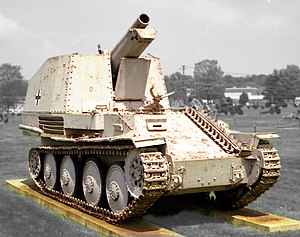Grille (artillery)
| Grille Ausf. M | |
|---|---|
 Grille Ausf. M on display at the US Army Ordnance Museum. | |
| Specifications | |
| Mass | 11.5 tonnes |
| Length | 4.95 m |
| Width | 2.15 m |
| Height | 2.47 m |
| Crew | 4 |
The Grille series of self propelled artillery vehicles were used by Germany during World War II. The Grille series was based on the Czech Panzer 38(t) tank and used a 15 cm sIG 33 infantry gun.
Development
The original order for 200 units of the Grille, was to be based on the new 38(t) Ausf M chassis that BMM was developing, however delays caused production to start on the 38(t) Ausf H chassis, using, in some cases, the older 38(t)'s returned for factory refit.
Grille Ausf. H
The first variant of the Grille ("Cricket") was based on the Panzer 38(t) Ausf. H, which had its engine in the rear. The turret of the tank was removed and replaced by a low-slung superstructure and fighting compartment. The 15 cm schweres Infanteriegeschütz 33 (heavy infantry gun) was mounted in the front of this armored compartment.
A total of 91 (including the one prototype) were produced in the BMM (erstwhile ČKD Praga) factory in Prague from February to April 1943. The official designation was 15 cm Schweres Infanteriegeschütz 33 (Sf) auf Panzerkampfwagen 38(t) Ausf. H (Sd.Kfz. 138/1).
As the Ausf H was built on a tank chassis it's hull armour was 50mm (front) and its superstructure armour was 25mm (front)
Grille Ausf. M
The second Grille variant was based on the Panzer 38(t) Ausf. M, which had its engine in the middle. As with the earlier version, the turret was removed and replaced with a new superstructure and armored compartment. Unlike the Ausf. H variant of the Bison, this was located at the rear of the vehicle, as well as somewhat smaller and higher. This version also carried the 15 cm schweres Infanteriegeschütz 33.
From April to June 1943 and then from October 1943 to September 1944 a total of 282 vehicles were produced, as well a 120 ammuniton carriers, which replaced the main gun with ammunition racks. These could be converted back to normal configuration in the field, by mounting the 15 cm gun onto the vehicle. The Grille Ausf M was the last vehicle built on the Ausf M chassis as the 10 that had been allocated to the Flakpanzer 38(t) chassis were used to build Grille's instead.
The official designation was 15cm Schweres Infanteriegeschütz 33/1 auf Selbstfahrlafette 38(t) (Sf) Ausf. M (Sd.Kfz. 138/1)
Combat history
Both versions were intended to take service in the schwere Infantreriegeschütz Companies within the Panzergrenadier Regiments, inside Panzer and Panzergrenadier Divisions, in their heavy infantry gun units. Each detachment had six available.
References
- Chamberlain, Peter, and Hilary L. Doyle. Thomas L. Jentz (Technical Editor). Encyclopedia of German Tanks of World War Two: A Complete Illustrated Directory of German Battle Tanks, Armoured Cars, Self-propelled Guns, and Semi-tracked Vehicles, 1933–1945. London: Arms and Armour Press, 1978 (revised edition 1993). ISBN 0-85368-202-X; rev. ed. ISBN 1-85409-214-6.

